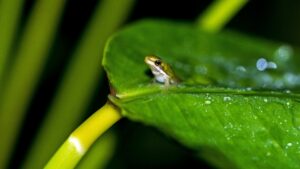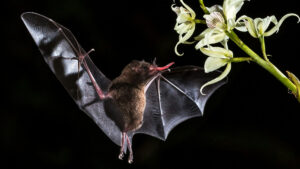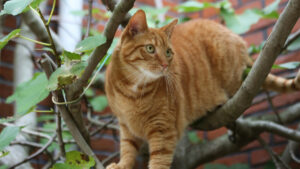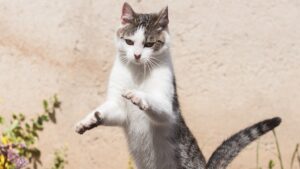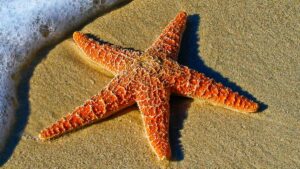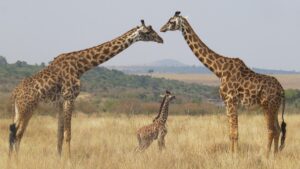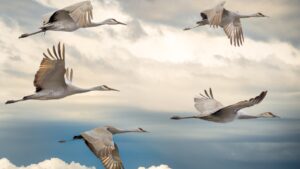Elephants, those magnificent giants of the animal kingdom, have always held a special place in our hearts. These gentle giants captivate us with their intelligence, social bonds, and immense strength. However, there’s one lesser-known aspect of these creatures that has gained attention in recent years — their artistic abilities. We delve into the realm of elephant art, exploring the creativity of these animals, the controversies it sparks, and the conservation efforts intertwined with this practice.
The art of elephant painting
Before we address the ethical concerns, we’ll cover elephant painting from a purely artistic perspective. At first glance, the idea of elephants creating art might seem improbable. However, when you delve into the intricacies of their abilities, it’s both astonishing and inspiring.
Elephant art typically involves the use of non-toxic paints and canvas. Trainers often guide the elephants, teaching them how to hold a brush and apply it to the canvas. The results are mesmerizing, with vibrant strokes, swirls, and patterns coming together to form beautiful, abstract works of art.
Creativity in the animal kingdom

The ability of elephants to create art is a testament to their remarkable intelligence. These animals exhibit a level of creativity that challenges the traditional view of art as a uniquely human endeavor. The paintings they produce are not merely random strokes but often display a degree of intention and creativity. Elephants appear to enjoy the process, and their artistic expressions are often a source of enrichment and mental stimulation.
Controversy surrounding elephant art
While the idea of elephants creating art is undoubtedly captivating, it is not without controversy. The ethical concerns raised about this practice revolve around the well-being of the elephants involved. Critics such as Treehugger and PETA argue that the training process may subject the animals to undue stress and discomfort. Trainers sometimes employ positive reinforcement techniques, while others have faced accusations of coercion and mistreatment.
In response to these concerns, many organizations and sanctuaries have developed strict guidelines for elephant art activities. These guidelines prioritize the welfare of the elephants, ensuring that they are not forced into the artistic process and that the activities are entirely voluntary. Transparency in the training process and close supervision during painting sessions are key components of these ethical standards.
Conservation through art
One of the silver linings in the debate over elephant art is the positive impact it can have on elephant conservation. The funds generated from the sale of elephant art often go toward supporting conservation efforts, including protecting elephants’ natural habitats and rescuing and rehabilitating orphaned or injured elephants.
Many organizations that promote elephant art also actively engage in conservation initiatives. By combining art and conservation, they raise awareness about the critical need to protect these animals and their habitats. This dual-purpose approach creates a win-win situation, benefiting both the elephants and their wild counterparts.
A closer look at responsible elephant art programs
For those intrigued by the idea of elephant art, it’s essential to support responsible programs and organizations that prioritize elephant welfare. These organizations are transparent about their training techniques and are committed to providing the best possible conditions for their elephants. Visitors can witness the art creation process while ensuring that the elephants are comfortable and content.
Some renowned elephant sanctuaries and organizations that offer responsible elephant art experiences include the Elephant Nature Park in Thailand and the Elephant Sanctuary in Tennessee. By supporting these ethical initiatives, visitors can enjoy the magic of elephant art while contributing to the well-being and conservation of these incredible animals.
The future of elephant painting
The debate surrounding elephant painting continues to evolve. As awareness of animal welfare issues grows, responsible practices and ethical guidelines are becoming more widespread. Hopefully, the future of elephant art will see an increasing emphasis on the well-being of the elephants involved.
In the long run, the practice of elephant art could serve as a powerful tool for conservation, demonstrating the need to protect these magnificent creatures and their natural habitats. It also challenges our understanding of creativity in the animal kingdom, inviting us to appreciate the remarkable intelligence and abilities of elephants. However, the health and welfare of the elephants should be the utmost priority.
Intersection of art, ethics, and conservation
The artistry of elephant painting is a fascinating realm where creativity, controversy, and conservation intersect. While it sparks ethical debates, the undeniable creativity of these remarkable animals serves as a reminder of the rich tapestry of life on our planet. By supporting responsible elephant art initiatives, we can both enjoy the beauty of their creations and contribute to the vital cause of elephant conservation. Again, the ethical concerns have merit, though, so humane practices that emphasize animal welfare are crucial.
As we continue to explore the world of elephant art, let us remember that, just like the paintings they create, these animals are masterpieces of nature. Their art reflects their intelligence, resilience, and the profound need for our efforts to ensure their survival in the wild.
RELATED: Elephant Miraculously Walks Again With Giant Prosthetic Foot
Header image: Elephant painting on canvas / Real Wild via YouTube
I’m Mark Putzer, and my passion for animals and all things nature is a life-long love affair. Growing up in Wisconsin, I had many cherished memories of hiking, skiing, and enjoying the abundant wildlife in the Badger State.
My passion for animals led me to marine biology research for my studies at the University of Wisconsin. I researched the behavior and communication of humpback whales around Hawaii and Orca Whales around the San Juan Islands of Washington State. The experience of being close to these massive and magnificent creatures is amazing. Later, I taught outdoor education to children in California — passing along my knowledge of animals and nature to the curious minds of the next generation. I also love pets. This includes a Labrador Retriever dog named “Molly” when I was a kid — and now, an adventurous tabby cat named “Rosy.”
I’m here to share the wonders of the animal kingdom with you. Whether it’s a cherished pet at home or an animal out in the wild, there are many unique stories and interesting information to share on Weird Animal News! Enjoy!

